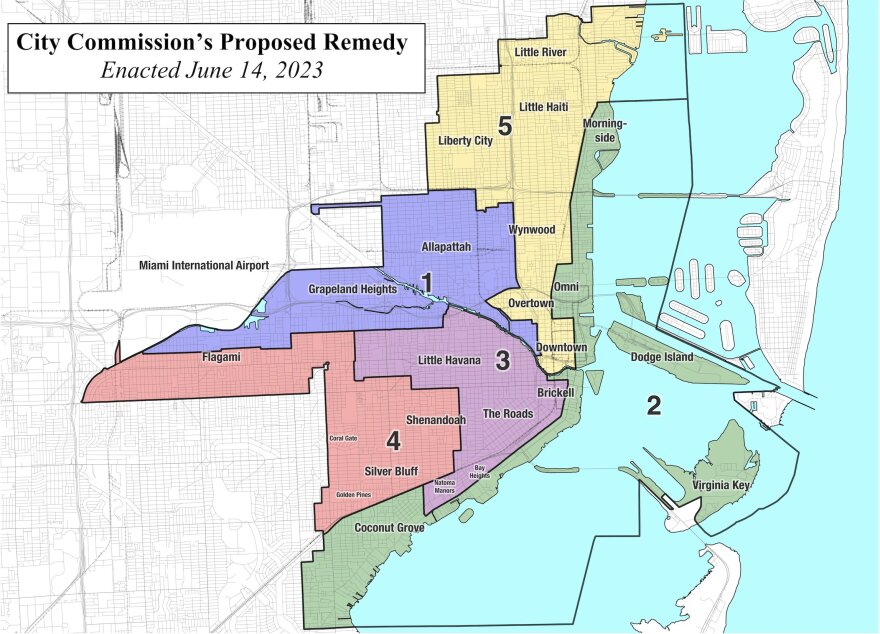Miami city commissioners have selected a new district map that they contend complies with the U.S. Constitution — but local activists have already indicated they will file an objection to it.
Last month, a federal judge determined Miami leaders likely racially gerrymandered the city’s district map, in violation of the Fourteenth Amendment. Judge K. Michael Moore was ruling on a legal complaint — filed by the ACLU on behalf of local activist groups — that claimed the city drew districts based on their racial makeup. He ordered the city to go back to the drawing board.
At a a special Miami City Commission meeting on Wednesday, map consultant Miguel De Grandy presented several versions of a district map, intended to meet the court’s requirements — and the commissioners’ preferences.
Commissioner Christine King, for instance, asked that District 5 maintain the entirety of the Overtown neighborhood, as well as the economic drivers in the Wharf area along the Miami River.
But not all of them got their wishes. Commissioner Sabina Covo of District 2 said she wanted to keep Coconut Grove "united" within her district, a major priority for her constituents. The approved map nonetheless split part of the neighborhood into District 3, which Commissioner Alex Diaz de la Portilla argued was needed due to population growth.
READ MORE: Federal judge throws out Miami district map over allegations of racial gerrymandering
Alexandra Contreras, a plaintiff in the racial gerrymandering suit, said afterwards that the new map is a disappointment.
"We are beyond disappointed in the Commission's actions today. They are clearly not interested in listening to residents across the city who demand fair maps that unite neighborhoods, not divide us along racial lines," she said in a written statement. "We will continue fighting for fair representation for all Miami."
The city must now submit its proposed map to the federal court for approval, and the plaintiffs may file objections. It will ultimately be up to the court to decide which map the city can use for the November local elections, and the court may appoint a third party to draw one up that meets all necessary requirements.
ACLU of Florida attorney Nick Warren told WLRN that the plaintiffs intend to object to the city's proposed map before the judge.
Plaintiffs proposed maps, then mediation
The plaintiffs — who include groups like Engage Miami and Grove Rights and Community Equity (GRACE) — had already unveiled two proposed maps last week, which they say are more 'logical' and do not racially gerrymander.
During the special meeting, which came after a court-ordered mediation on Tuesday, De Grandy countered with his own proposed map on the city’s behalf, maintaining some of the jagged edges of the city’s previous map. He argues this was necessary to keep population numbers balanced.
The final map that the city approved was based on that proposal, with slight modifications after input from commissioners.
At Wednesday's meeting De Grandy, a former Republican member of the Florida House of Representatives, complained that the plaintiffs’ proposed maps were based on “political” objectives by moving conservative voters out of certain districts.
But during the public comment period, residents and Commissioner Joe Carollo pointed out that the city’s elections are nonpartisan and do not include considerations of political party.
Responding to De Grandy's assertions, Reverend Nathaniel Robinson III, one of the plaintiffs in the lawsuit, said: “What’s being presented here today is somewhat of a false narrative in my opinion. As residents of the city, we are doing our best to help and assist the city by offering recommendations."
Houses shift between districts, more legal action
The new map maintains Commissioner Carollo’s Coconut Grove property in District 3, his district. The plaintiffs’ maps sought to keep all of Coconut Grove in District 2, which would force Carollo to move out of his home to keep his elected seat.
But Carollo’s wasn’t the only house that shifted between districts within the new map.
Miguel Angel Gabela, a political candidate in District 1 who ran against Commissioner Alex Diaz De La Portilla in 2019, came to the commission to ask where his house had been moved in the city’s latest map. Gabela has been campaigning in District 1, where he lives, since February. In De Grandy’s map shown at the meeting, Gabela’s home was moved from District 1 into District 3, prompting him to threaten legal action.
“You don't need any more lawsuits in the city of Miami. Please don't do this to me. And don't make me go out and get myself an attorney and have to sue the city because I don't want to do this,” Gabela said.
Gabela's attorney, David Winker, said he intends to take legal action. "The City has made clear that it can't do this redistricting honestly and fairly. We need an independent process under the supervision of the federal judge," Winker told WLRN.
The activist groups behind the lawsuit were set to hold a community meeting on Wednesday at 6:30 p.m. at the Overtown Performing Arts Center, to get feedback from residents on the plaintiffs’ proposed maps.






